2025.03.13

Starting in April 2025, low-GWP* refrigerants will become mandatory for multi-system air-conditioners sold in Japan for commercial buildings (new installations, cooling/heating changeover type).
Mitsubishi Heavy Industries Thermal Systems, Ltd., will release a new air-conditioner series that is fully remodeled and adopts low GWP refrigerant.
Mitsubishi Heavy Industries Thermal Systems, a member of the Mitsubishi Heavy Industries Group, will release the LXZ Series of multi-system air-conditioners for commercial buildings adopting the low-GWP* R32 refrigerant. The Japanese government has mandated that multi-system air-conditioners for commercial buildings (new installations, cooling/heating changeover type) must have a GWP value below 750. By adopting the R32 refrigerant, the LXZ Series reduces the GWP to about one-third of conventional models.
*GWP (global warming potential): A value that indicates how many times more greenhouse effect a substance has than CO2.
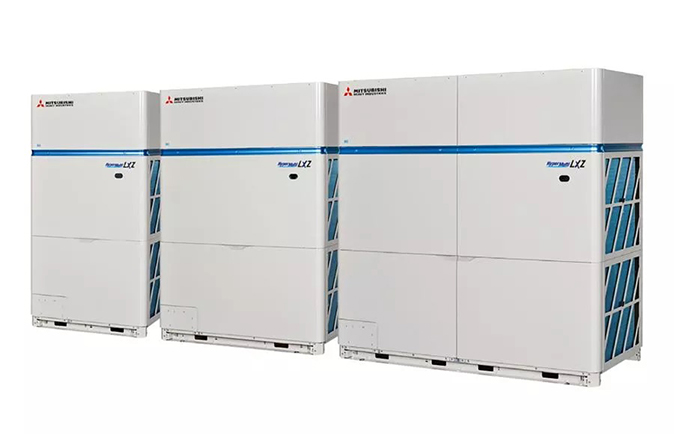
The LXZ series
In March 2025, Mitsubishi Heavy Industries Thermal Systems, an MHI Group member, will start sequentially releasing the LXZ Series multi-system air-conditioners using the R32 refrigerant for domestic commercial buildings. The R32 refrigerant has a low GWP (global warming potential) that helps reduce environmental impact. Additionally, the series has a new compressor and an air flow path design, as well as a new control system to improve comfort while saving energy costs. The new flat front panel of the outdoor unit has an improved design with a blue ornament that enhances integrity when multiple units are installed in a row.
Mr. Yuzuru Zushida works in the company's marketing department, leading product planning and sales support for commercial products.
He explains: "This is the series' first major model change in 20 years involving both design and refrigerant. As we developed the units, we added a medium capacity model to the two existing types, small and large, and standardized the height of the units. Also, we overhauled the design completely. The front panel is now flat with blue ornamentation to suggest high quality while improving the integrity and aesthetic appeal when the units are installed together. We want to emphasize that we pursued the best outcome for every small detail in developing the product, even though these are outdoor units. We hope our attention to detail, together with our environmental measures, will differentiate the new series from other products."
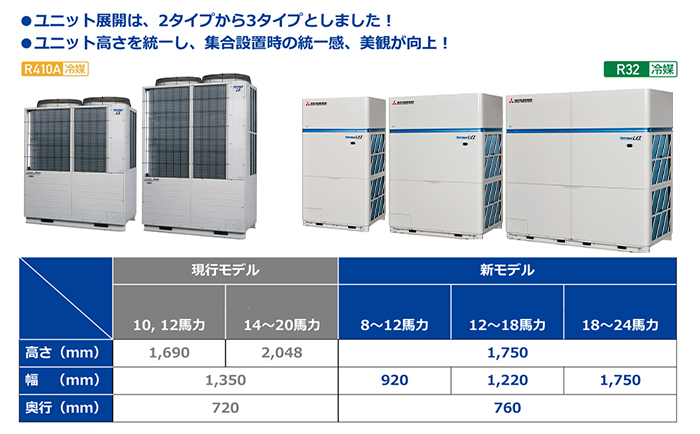
Outdoor units
Mitsubishi Heavy Industries Thermal Systems contributes to achieving carbon neutrality for the MHI Group
Starting in April 2025, low GWP refrigerant will become mandatory for multi-system air-conditioners for commercial buildings (new installations, cooling/heating changeover type)
The letter "Z" in the LXZ Series indicates that it is the ultimate version of the LX Series of multi-system air-conditioners for commercial buildings. The series' significance is that it dramatically reduces environmental impact by adopting R32 refrigerant (GWP 675), which has a global warming potential of about a third of the conventional R410A refrigerant (GWP 2,090).
"The government aims to achieve carbon neutrality by 2050, reducing overall greenhouse gas emissions to zero," Mr. Zushida points out. "Under the Fluorocarbon Emissions Control Act, multi-system air-conditioners for commercial buildings (newly installed, heating/cooling changeover type) are one of the designated products that must keep a GWP value of 750 or less after April 2025. The products that do not utilize low-GWP refrigerant will be restricted from sale. We redesigned the LXZ Series to meet the new requirements. Besides, as you know, the MHI Group has set a target of achieving carbon neutrality by 2040, ahead of the government. We believe we can contribute to reducing environmental impact by developing high-performance products using low-GWP refrigerant while offering optimal thermal solutions to satisfy the needs of various markets and customers."
New functions combine energy efficiency and comfort
The LXZ Series' new features include the Advanced Variable Temperature and Capacity Control + (VTCC+), a new control function that bolsters energy efficiency and comfort simultaneously. The target pressure of the refrigerant is automatically adjusted according to the load on the indoor unit to control the compressor speed, which makes possible energy-efficient operation through optimal temperature control. Users can change the settings between three modes according to their needs. Additionally, the defrosting operation of the outdoor unit employs the hot gas bypass defrost for operation control to ensure continuous, non-stop heating* by directing the flow of the hot gas indoors to the outdoor unit. It prevents the room temperature from dropping temporarily to an unpleasant level, which was sometimes a problem with conventional models.
Note: The unit may enter the defrost mode under certain installation and environmental conditions.
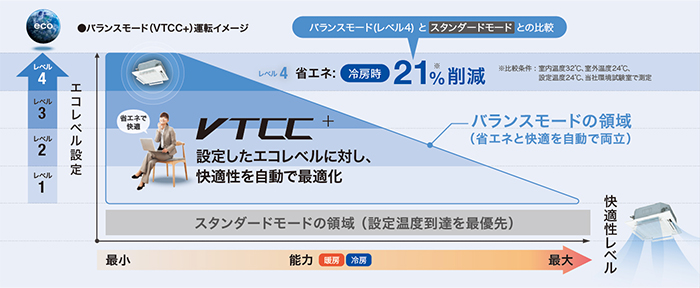
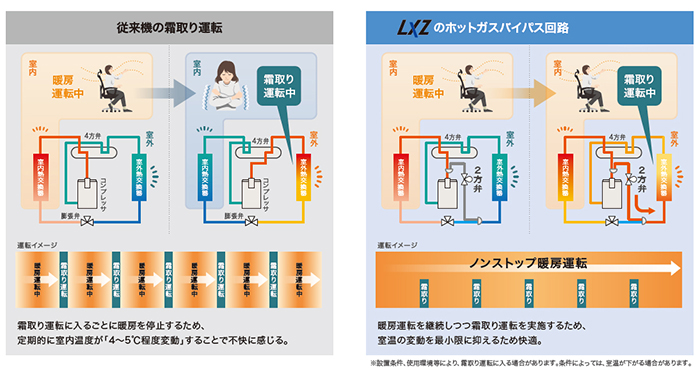
Non-stop heating by hot gas bypass
Furthermore, the small capacity model of the LXZ Series has a significantly reduced footprint with a higher-density heat exchanger with reduced-diameter copper tubes. By improving operating efficiency and reducing the size of outdoor units, the new series can support up to 54 horsepower when individual units are combined together.
"We pushed high performance and compact sizing to the limit," says Mr. Zushida, "and we have designed the series to respond flexibly under severe installation conditions."
To further improve energy efficiency, the series uses a new compressor optimized for R32 refrigerant and a new air flow path with a redesigned fan structure.
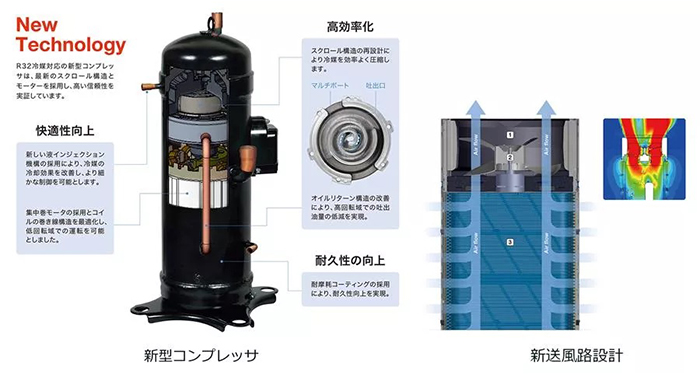
New compressor and deep flow path design to improve energy efficiency
"This is the first time the company has adopted the R32 refrigerant for use in multi-system air-conditioners for commercial buildings and integrated it into our system. We started from scratch, including a complete redesign of the exterior. We needed to reach and exceed the value of the annual performance factor (APF) index standard to achieve energy savings. The development team worked hard to meet the challenge and created a product that achieves improved energy efficiency through the design of a new model that uses a new refrigerant."
Following the new LXZ series cooling/heating changeover units for new installations,
the new features and refrigerant will be introduced to other lineups
In March 2024, the company launched the KXZ Series—the small capacity model of the LXZ Series—in Europe. Other lineups in the LXZ model are scheduled for sequential release.
In Japan, following the new LXZ cooling/heating changeover unit series, the company plans to gradually expand the use of R32 refrigerant and new control functions to other models, including those designed exclusively for replacement (replacing the indoor and outdoor units while keeping the existing refrigerant piping) and those that can operate cooling and heating simultaneously (with a single outdoor unit).
"With the government considering measures to further reduce GWP, we plan to continue developing technologies that can bring down GWP," says Mr. Zushida.
INTERVIEWEES
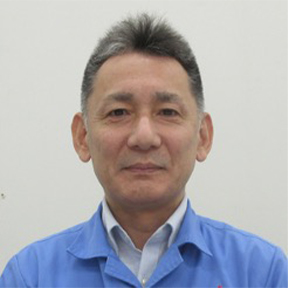
Yuzuru Zushida
Air-conditioner Marketing Group
Marketing Department
Mitsubishi Heavy Industries Thermal Systems, Ltd.
2-3, Marunouchi 3-chome, Chiyoda-ku
Mitsubishi Heavy Industries Thermal Systems, Ltd., was established as a separate company within Mitsubishi Heavy Industries (MHI) Group, taking over the air-conditioning and refrigeration business (domestic and overseas) of Mitsubishi Heavy Industries, Ltd. It is a wholly owned subsidiary of MHI. In 2016, it started as a manufacturer focused on the air-conditioning and refrigeration business. Currently, it operates in the thermal engineering business, where it is working to boost energy efficiency at various plants, and in the air-conditioning business, where it is dealing in large refrigeration machinery for high-rise office buildings, shopping malls, factories, and other large spaces. It is also active in the air-conditioning business, the transport refrigeration business, and the automotive air-conditioning systems business.
